Applying an Organizational Development Approach to Creating Diversity
VerifiedAdded on 2022/01/20
|28
|7120
|35
Report
AI Summary
This report, "Applying an Organizational Development Approach to Creating Diversity," explores how organizations can move beyond superficial diversity programs to create truly inclusive and multicultural workplaces. The authors, Richard S. Allen and Kendyl A. Montgomery, emphasize the importance of diversity in the 21st century, highlighting its benefits in terms of market share, customer understanding, employee motivation, and innovation. The report introduces Taylor Cox's typology of diversity, differentiating between monolithic, pluralistic, and multicultural organizations, and argues that only multicultural organizations, which value and integrate diverse perspectives, can achieve true success. It examines the reasons why many diversity programs fail, often due to a lack of internal commitment, generic approaches, and insufficient follow-up. The report proposes that a planned organizational change model based on organizational development principles can effectively transform corporate culture from exclusivity to inclusivity. It provides examples of companies that have attempted to address diversity challenges and underscores the need for tailored, research-based strategies to achieve lasting change and avoid negative consequences. This report is a valuable resource for managers seeking to reap the full benefits of a diverse workforce.
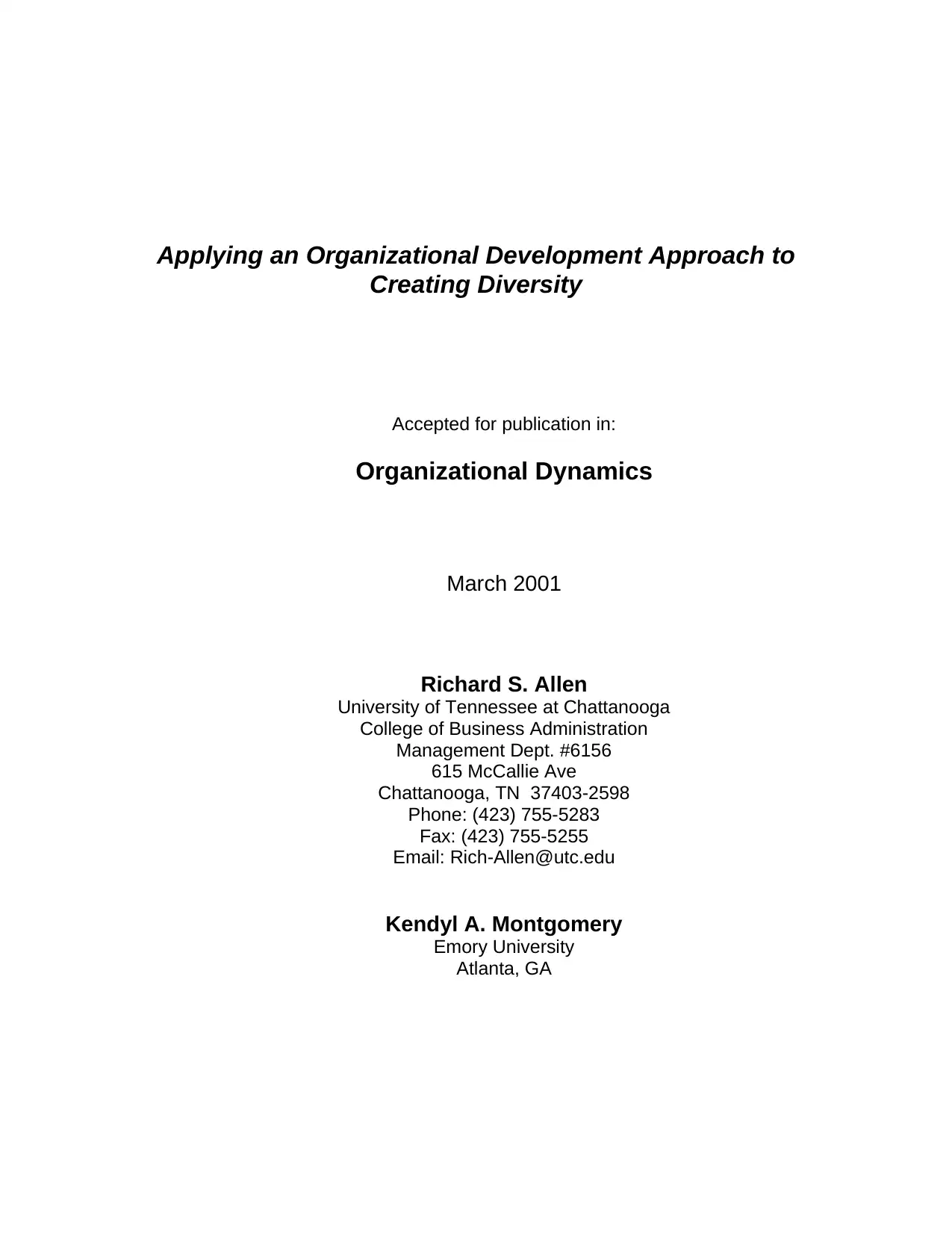
Applying an Organizational Development Approach to
Creating Diversity
Accepted for publication in:
Organizational Dynamics
March 2001
Richard S. Allen
University of Tennessee at Chattanooga
College of Business Administration
Management Dept. #6156
615 McCallie Ave
Chattanooga, TN 37403-2598
Phone: (423) 755-5283
Fax: (423) 755-5255
Email: Rich-Allen@utc.edu
Kendyl A. Montgomery
Emory University
Atlanta, GA
Creating Diversity
Accepted for publication in:
Organizational Dynamics
March 2001
Richard S. Allen
University of Tennessee at Chattanooga
College of Business Administration
Management Dept. #6156
615 McCallie Ave
Chattanooga, TN 37403-2598
Phone: (423) 755-5283
Fax: (423) 755-5255
Email: Rich-Allen@utc.edu
Kendyl A. Montgomery
Emory University
Atlanta, GA
Paraphrase This Document
Need a fresh take? Get an instant paraphrase of this document with our AI Paraphraser
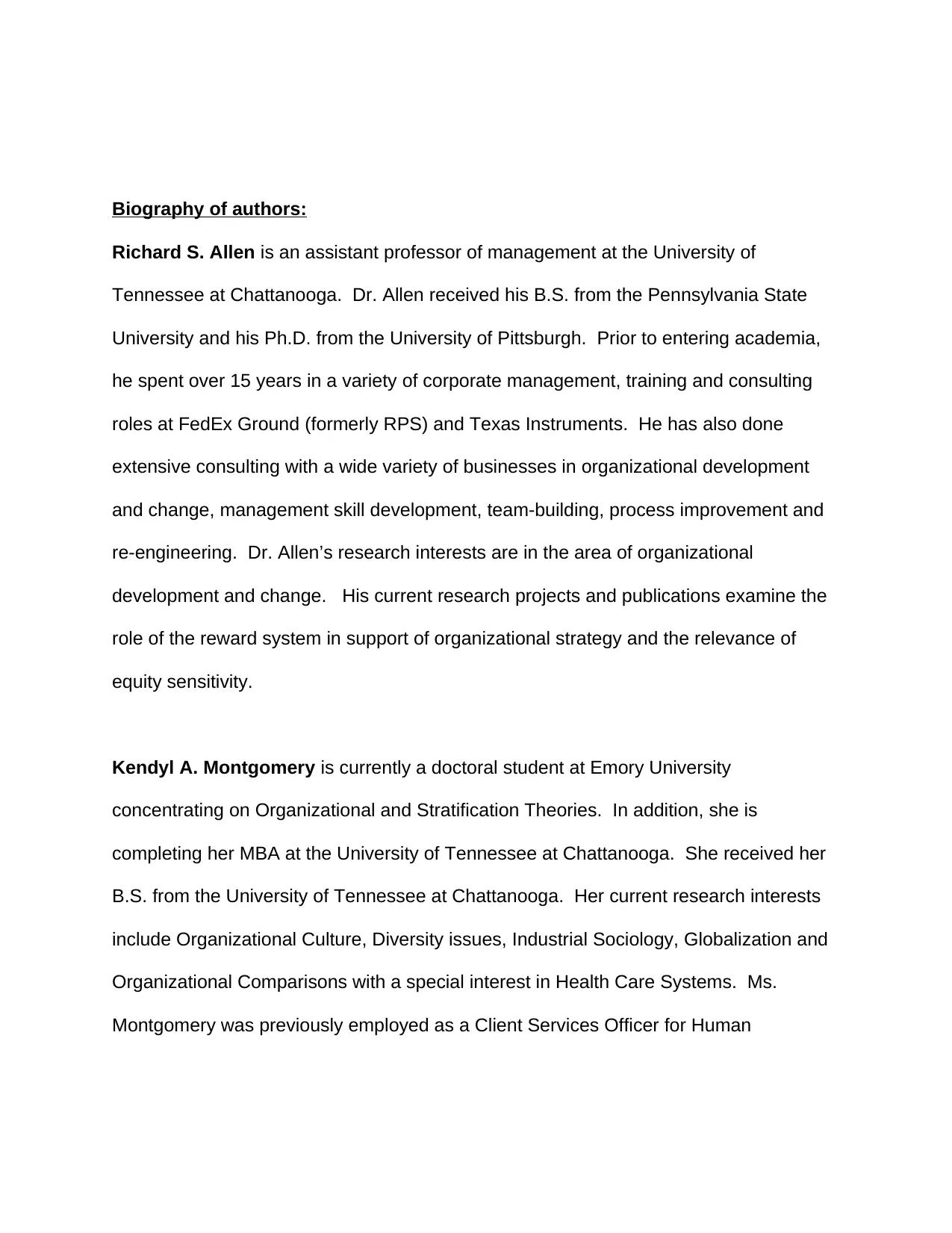
Biography of authors:
Richard S. Allen is an assistant professor of management at the University of
Tennessee at Chattanooga. Dr. Allen received his B.S. from the Pennsylvania State
University and his Ph.D. from the University of Pittsburgh. Prior to entering academia,
he spent over 15 years in a variety of corporate management, training and consulting
roles at FedEx Ground (formerly RPS) and Texas Instruments. He has also done
extensive consulting with a wide variety of businesses in organizational development
and change, management skill development, team-building, process improvement and
re-engineering. Dr. Allen’s research interests are in the area of organizational
development and change. His current research projects and publications examine the
role of the reward system in support of organizational strategy and the relevance of
equity sensitivity.
Kendyl A. Montgomery is currently a doctoral student at Emory University
concentrating on Organizational and Stratification Theories. In addition, she is
completing her MBA at the University of Tennessee at Chattanooga. She received her
B.S. from the University of Tennessee at Chattanooga. Her current research interests
include Organizational Culture, Diversity issues, Industrial Sociology, Globalization and
Organizational Comparisons with a special interest in Health Care Systems. Ms.
Montgomery was previously employed as a Client Services Officer for Human
Richard S. Allen is an assistant professor of management at the University of
Tennessee at Chattanooga. Dr. Allen received his B.S. from the Pennsylvania State
University and his Ph.D. from the University of Pittsburgh. Prior to entering academia,
he spent over 15 years in a variety of corporate management, training and consulting
roles at FedEx Ground (formerly RPS) and Texas Instruments. He has also done
extensive consulting with a wide variety of businesses in organizational development
and change, management skill development, team-building, process improvement and
re-engineering. Dr. Allen’s research interests are in the area of organizational
development and change. His current research projects and publications examine the
role of the reward system in support of organizational strategy and the relevance of
equity sensitivity.
Kendyl A. Montgomery is currently a doctoral student at Emory University
concentrating on Organizational and Stratification Theories. In addition, she is
completing her MBA at the University of Tennessee at Chattanooga. She received her
B.S. from the University of Tennessee at Chattanooga. Her current research interests
include Organizational Culture, Diversity issues, Industrial Sociology, Globalization and
Organizational Comparisons with a special interest in Health Care Systems. Ms.
Montgomery was previously employed as a Client Services Officer for Human
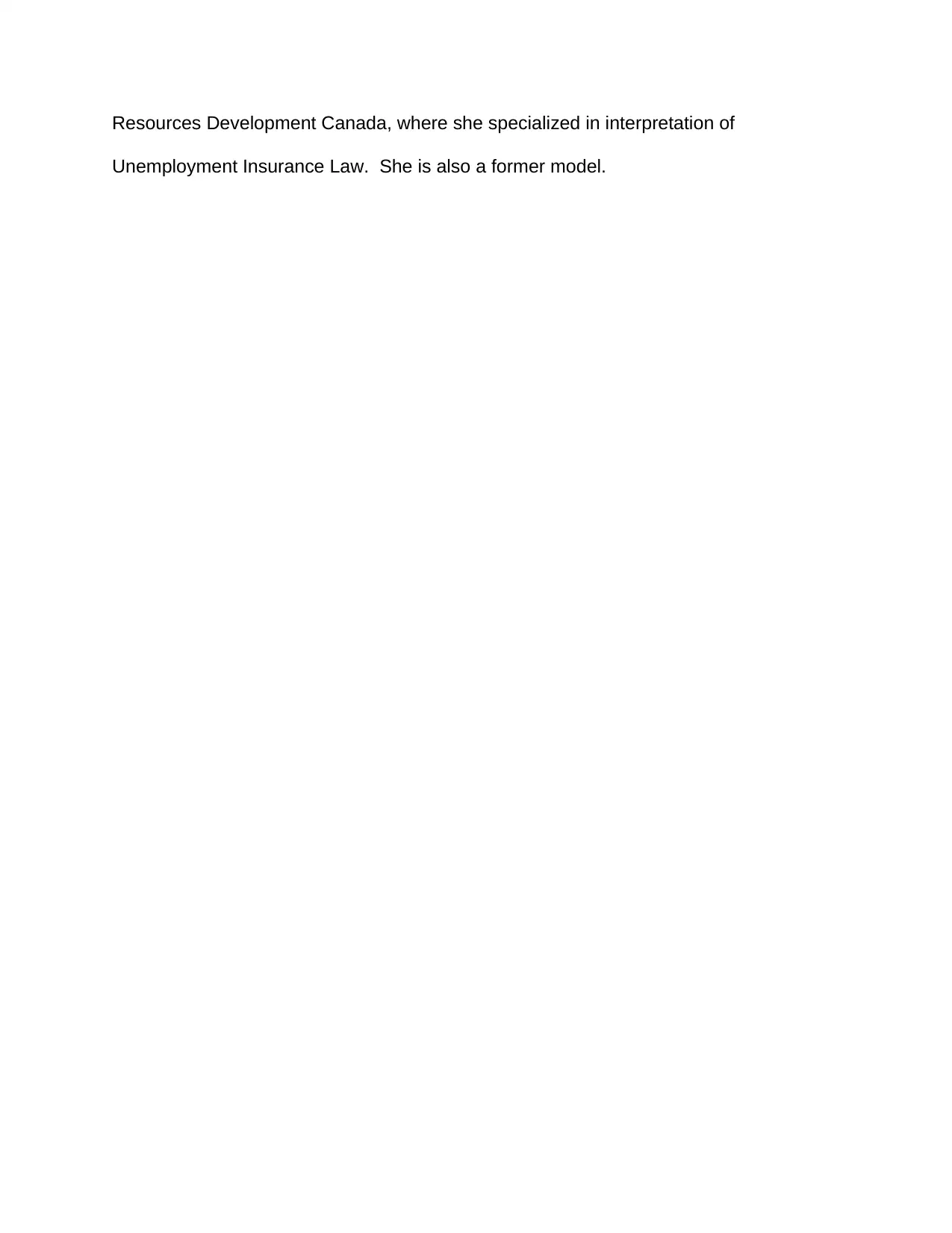
Resources Development Canada, where she specialized in interpretation of
Unemployment Insurance Law. She is also a former model.
Unemployment Insurance Law. She is also a former model.
⊘ This is a preview!⊘
Do you want full access?
Subscribe today to unlock all pages.

Trusted by 1+ million students worldwide
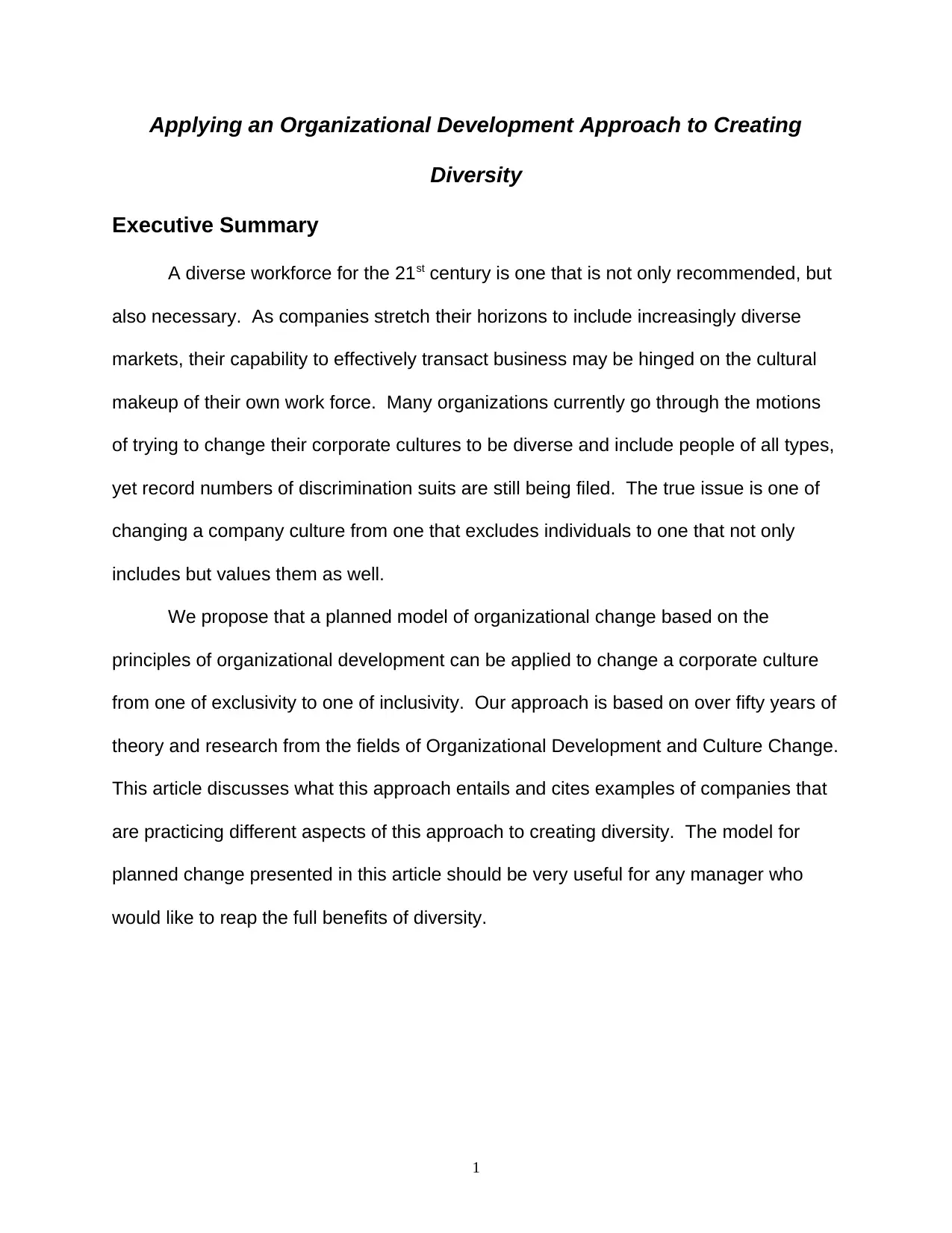
Applying an Organizational Development Approach to Creating
Diversity
Executive Summary
A diverse workforce for the 21st century is one that is not only recommended, but
also necessary. As companies stretch their horizons to include increasingly diverse
markets, their capability to effectively transact business may be hinged on the cultural
makeup of their own work force. Many organizations currently go through the motions
of trying to change their corporate cultures to be diverse and include people of all types,
yet record numbers of discrimination suits are still being filed. The true issue is one of
changing a company culture from one that excludes individuals to one that not only
includes but values them as well.
We propose that a planned model of organizational change based on the
principles of organizational development can be applied to change a corporate culture
from one of exclusivity to one of inclusivity. Our approach is based on over fifty years of
theory and research from the fields of Organizational Development and Culture Change.
This article discusses what this approach entails and cites examples of companies that
are practicing different aspects of this approach to creating diversity. The model for
planned change presented in this article should be very useful for any manager who
would like to reap the full benefits of diversity.
1
Diversity
Executive Summary
A diverse workforce for the 21st century is one that is not only recommended, but
also necessary. As companies stretch their horizons to include increasingly diverse
markets, their capability to effectively transact business may be hinged on the cultural
makeup of their own work force. Many organizations currently go through the motions
of trying to change their corporate cultures to be diverse and include people of all types,
yet record numbers of discrimination suits are still being filed. The true issue is one of
changing a company culture from one that excludes individuals to one that not only
includes but values them as well.
We propose that a planned model of organizational change based on the
principles of organizational development can be applied to change a corporate culture
from one of exclusivity to one of inclusivity. Our approach is based on over fifty years of
theory and research from the fields of Organizational Development and Culture Change.
This article discusses what this approach entails and cites examples of companies that
are practicing different aspects of this approach to creating diversity. The model for
planned change presented in this article should be very useful for any manager who
would like to reap the full benefits of diversity.
1
Paraphrase This Document
Need a fresh take? Get an instant paraphrase of this document with our AI Paraphraser
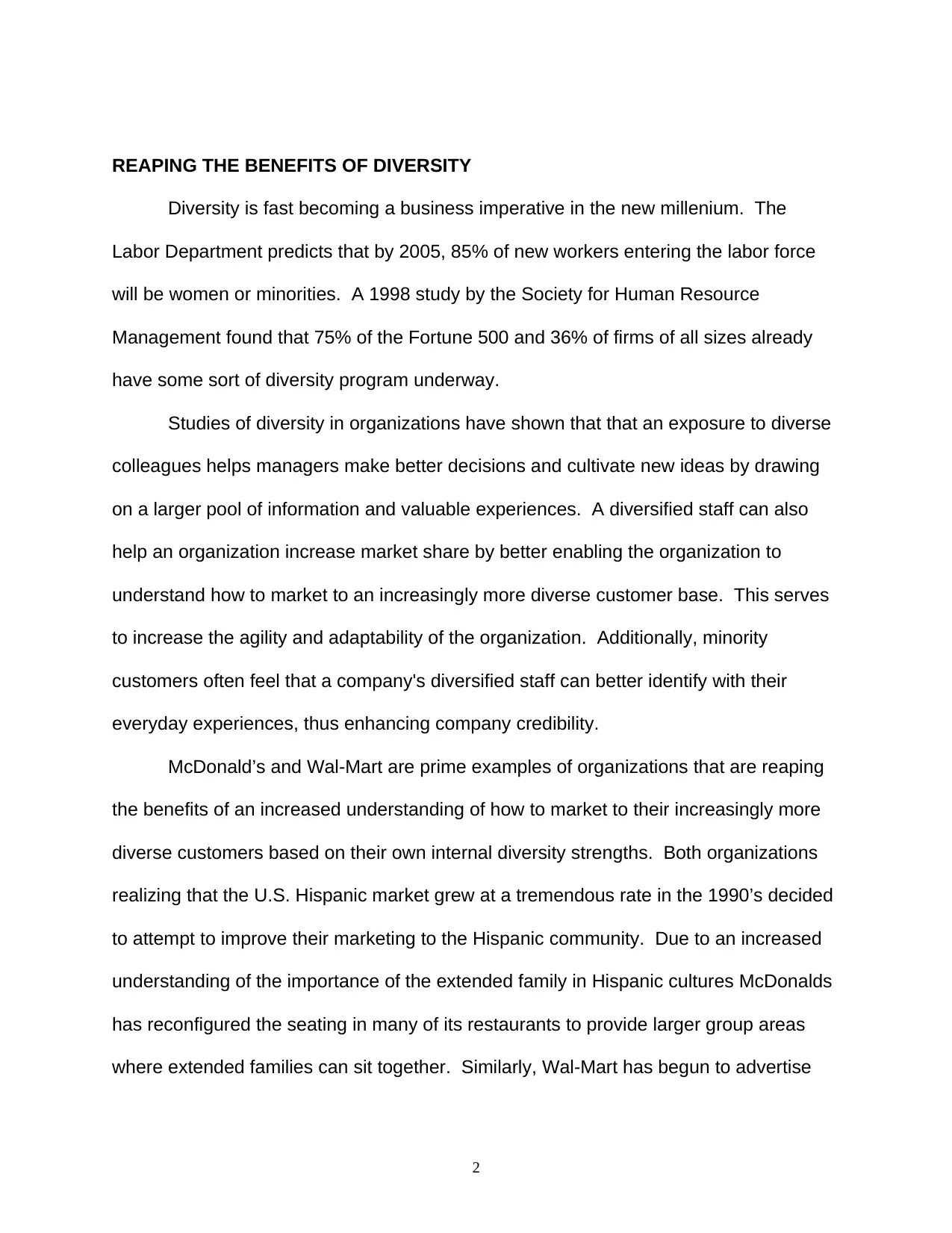
REAPING THE BENEFITS OF DIVERSITY
Diversity is fast becoming a business imperative in the new millenium. The
Labor Department predicts that by 2005, 85% of new workers entering the labor force
will be women or minorities. A 1998 study by the Society for Human Resource
Management found that 75% of the Fortune 500 and 36% of firms of all sizes already
have some sort of diversity program underway.
Studies of diversity in organizations have shown that that an exposure to diverse
colleagues helps managers make better decisions and cultivate new ideas by drawing
on a larger pool of information and valuable experiences. A diversified staff can also
help an organization increase market share by better enabling the organization to
understand how to market to an increasingly more diverse customer base. This serves
to increase the agility and adaptability of the organization. Additionally, minority
customers often feel that a company's diversified staff can better identify with their
everyday experiences, thus enhancing company credibility.
McDonald’s and Wal-Mart are prime examples of organizations that are reaping
the benefits of an increased understanding of how to market to their increasingly more
diverse customers based on their own internal diversity strengths. Both organizations
realizing that the U.S. Hispanic market grew at a tremendous rate in the 1990’s decided
to attempt to improve their marketing to the Hispanic community. Due to an increased
understanding of the importance of the extended family in Hispanic cultures McDonalds
has reconfigured the seating in many of its restaurants to provide larger group areas
where extended families can sit together. Similarly, Wal-Mart has begun to advertise
2
Diversity is fast becoming a business imperative in the new millenium. The
Labor Department predicts that by 2005, 85% of new workers entering the labor force
will be women or minorities. A 1998 study by the Society for Human Resource
Management found that 75% of the Fortune 500 and 36% of firms of all sizes already
have some sort of diversity program underway.
Studies of diversity in organizations have shown that that an exposure to diverse
colleagues helps managers make better decisions and cultivate new ideas by drawing
on a larger pool of information and valuable experiences. A diversified staff can also
help an organization increase market share by better enabling the organization to
understand how to market to an increasingly more diverse customer base. This serves
to increase the agility and adaptability of the organization. Additionally, minority
customers often feel that a company's diversified staff can better identify with their
everyday experiences, thus enhancing company credibility.
McDonald’s and Wal-Mart are prime examples of organizations that are reaping
the benefits of an increased understanding of how to market to their increasingly more
diverse customers based on their own internal diversity strengths. Both organizations
realizing that the U.S. Hispanic market grew at a tremendous rate in the 1990’s decided
to attempt to improve their marketing to the Hispanic community. Due to an increased
understanding of the importance of the extended family in Hispanic cultures McDonalds
has reconfigured the seating in many of its restaurants to provide larger group areas
where extended families can sit together. Similarly, Wal-Mart has begun to advertise
2
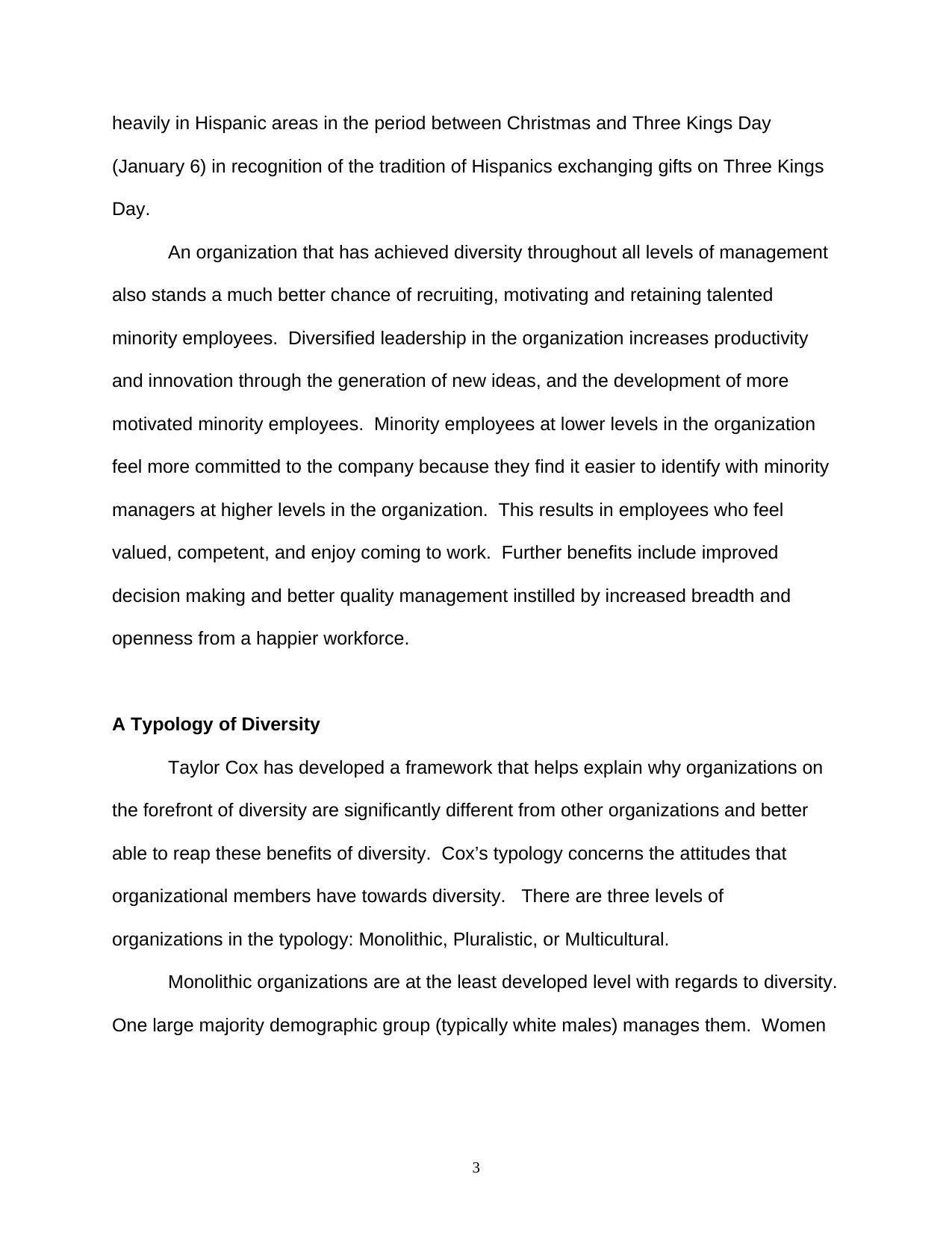
heavily in Hispanic areas in the period between Christmas and Three Kings Day
(January 6) in recognition of the tradition of Hispanics exchanging gifts on Three Kings
Day.
An organization that has achieved diversity throughout all levels of management
also stands a much better chance of recruiting, motivating and retaining talented
minority employees. Diversified leadership in the organization increases productivity
and innovation through the generation of new ideas, and the development of more
motivated minority employees. Minority employees at lower levels in the organization
feel more committed to the company because they find it easier to identify with minority
managers at higher levels in the organization. This results in employees who feel
valued, competent, and enjoy coming to work. Further benefits include improved
decision making and better quality management instilled by increased breadth and
openness from a happier workforce.
A Typology of Diversity
Taylor Cox has developed a framework that helps explain why organizations on
the forefront of diversity are significantly different from other organizations and better
able to reap these benefits of diversity. Cox’s typology concerns the attitudes that
organizational members have towards diversity. There are three levels of
organizations in the typology: Monolithic, Pluralistic, or Multicultural.
Monolithic organizations are at the least developed level with regards to diversity.
One large majority demographic group (typically white males) manages them. Women
3
(January 6) in recognition of the tradition of Hispanics exchanging gifts on Three Kings
Day.
An organization that has achieved diversity throughout all levels of management
also stands a much better chance of recruiting, motivating and retaining talented
minority employees. Diversified leadership in the organization increases productivity
and innovation through the generation of new ideas, and the development of more
motivated minority employees. Minority employees at lower levels in the organization
feel more committed to the company because they find it easier to identify with minority
managers at higher levels in the organization. This results in employees who feel
valued, competent, and enjoy coming to work. Further benefits include improved
decision making and better quality management instilled by increased breadth and
openness from a happier workforce.
A Typology of Diversity
Taylor Cox has developed a framework that helps explain why organizations on
the forefront of diversity are significantly different from other organizations and better
able to reap these benefits of diversity. Cox’s typology concerns the attitudes that
organizational members have towards diversity. There are three levels of
organizations in the typology: Monolithic, Pluralistic, or Multicultural.
Monolithic organizations are at the least developed level with regards to diversity.
One large majority demographic group (typically white males) manages them. Women
3
⊘ This is a preview!⊘
Do you want full access?
Subscribe today to unlock all pages.

Trusted by 1+ million students worldwide
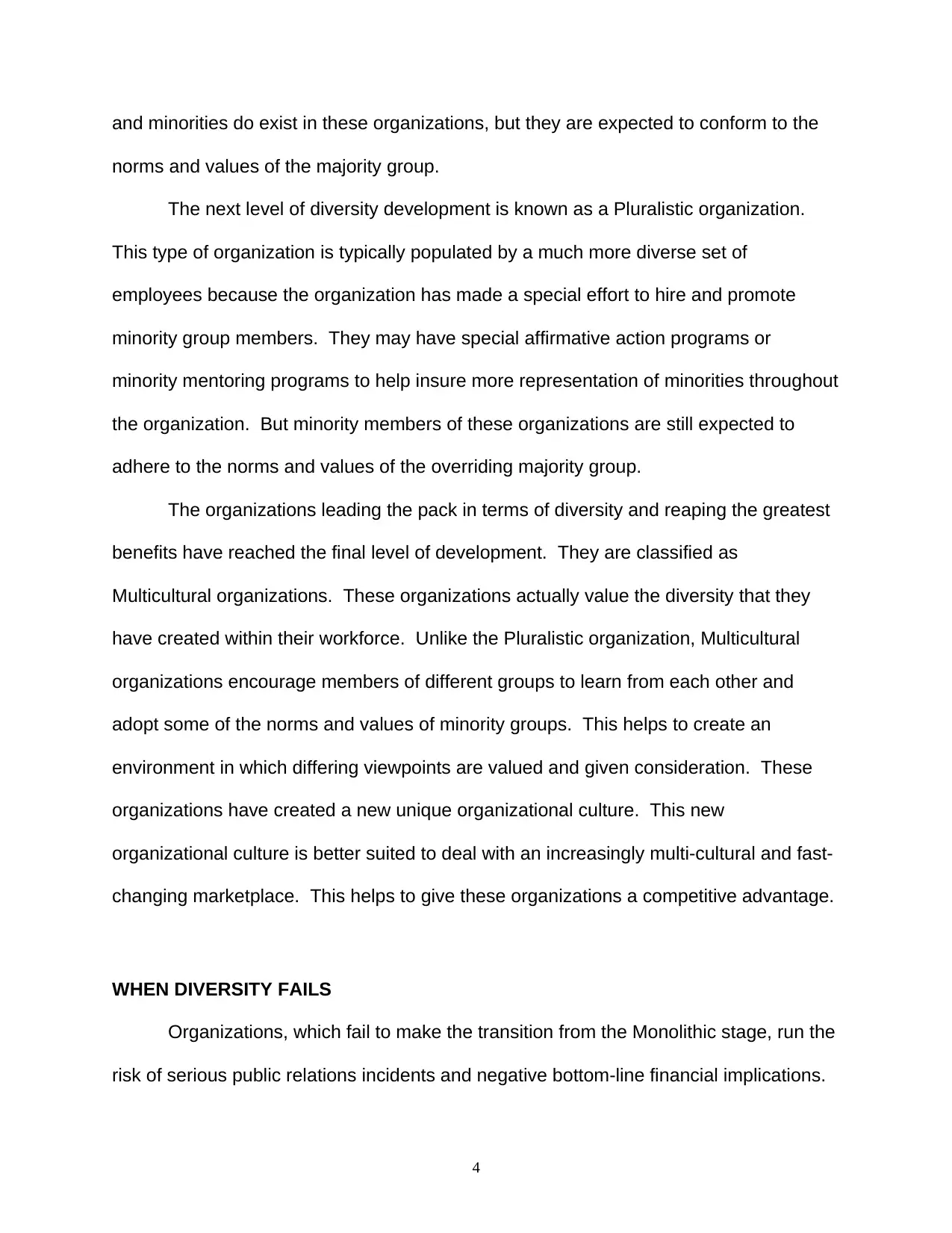
and minorities do exist in these organizations, but they are expected to conform to the
norms and values of the majority group.
The next level of diversity development is known as a Pluralistic organization.
This type of organization is typically populated by a much more diverse set of
employees because the organization has made a special effort to hire and promote
minority group members. They may have special affirmative action programs or
minority mentoring programs to help insure more representation of minorities throughout
the organization. But minority members of these organizations are still expected to
adhere to the norms and values of the overriding majority group.
The organizations leading the pack in terms of diversity and reaping the greatest
benefits have reached the final level of development. They are classified as
Multicultural organizations. These organizations actually value the diversity that they
have created within their workforce. Unlike the Pluralistic organization, Multicultural
organizations encourage members of different groups to learn from each other and
adopt some of the norms and values of minority groups. This helps to create an
environment in which differing viewpoints are valued and given consideration. These
organizations have created a new unique organizational culture. This new
organizational culture is better suited to deal with an increasingly multi-cultural and fast-
changing marketplace. This helps to give these organizations a competitive advantage.
WHEN DIVERSITY FAILS
Organizations, which fail to make the transition from the Monolithic stage, run the
risk of serious public relations incidents and negative bottom-line financial implications.
4
norms and values of the majority group.
The next level of diversity development is known as a Pluralistic organization.
This type of organization is typically populated by a much more diverse set of
employees because the organization has made a special effort to hire and promote
minority group members. They may have special affirmative action programs or
minority mentoring programs to help insure more representation of minorities throughout
the organization. But minority members of these organizations are still expected to
adhere to the norms and values of the overriding majority group.
The organizations leading the pack in terms of diversity and reaping the greatest
benefits have reached the final level of development. They are classified as
Multicultural organizations. These organizations actually value the diversity that they
have created within their workforce. Unlike the Pluralistic organization, Multicultural
organizations encourage members of different groups to learn from each other and
adopt some of the norms and values of minority groups. This helps to create an
environment in which differing viewpoints are valued and given consideration. These
organizations have created a new unique organizational culture. This new
organizational culture is better suited to deal with an increasingly multi-cultural and fast-
changing marketplace. This helps to give these organizations a competitive advantage.
WHEN DIVERSITY FAILS
Organizations, which fail to make the transition from the Monolithic stage, run the
risk of serious public relations incidents and negative bottom-line financial implications.
4
Paraphrase This Document
Need a fresh take? Get an instant paraphrase of this document with our AI Paraphraser
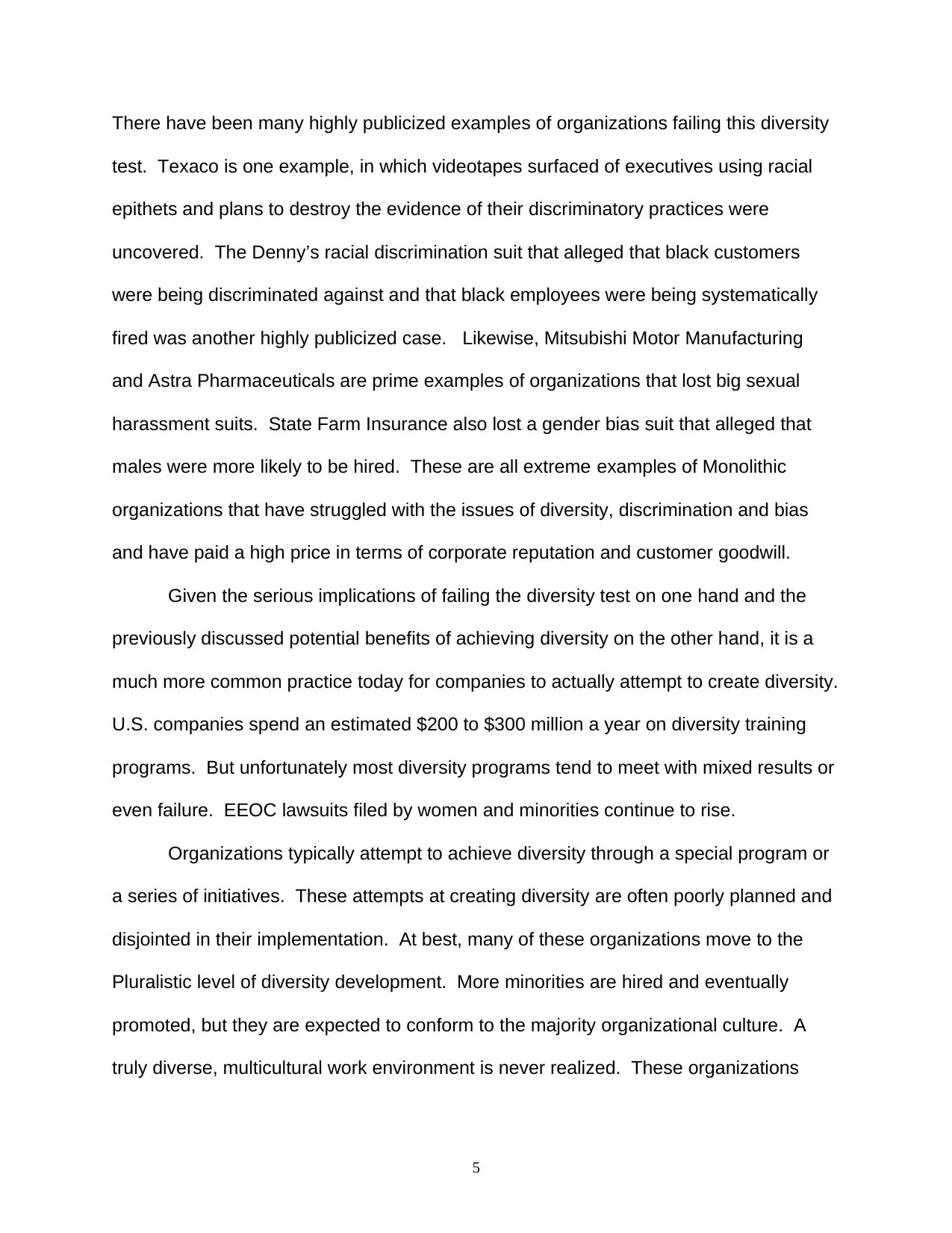
There have been many highly publicized examples of organizations failing this diversity
test. Texaco is one example, in which videotapes surfaced of executives using racial
epithets and plans to destroy the evidence of their discriminatory practices were
uncovered. The Denny’s racial discrimination suit that alleged that black customers
were being discriminated against and that black employees were being systematically
fired was another highly publicized case. Likewise, Mitsubishi Motor Manufacturing
and Astra Pharmaceuticals are prime examples of organizations that lost big sexual
harassment suits. State Farm Insurance also lost a gender bias suit that alleged that
males were more likely to be hired. These are all extreme examples of Monolithic
organizations that have struggled with the issues of diversity, discrimination and bias
and have paid a high price in terms of corporate reputation and customer goodwill.
Given the serious implications of failing the diversity test on one hand and the
previously discussed potential benefits of achieving diversity on the other hand, it is a
much more common practice today for companies to actually attempt to create diversity.
U.S. companies spend an estimated $200 to $300 million a year on diversity training
programs. But unfortunately most diversity programs tend to meet with mixed results or
even failure. EEOC lawsuits filed by women and minorities continue to rise.
Organizations typically attempt to achieve diversity through a special program or
a series of initiatives. These attempts at creating diversity are often poorly planned and
disjointed in their implementation. At best, many of these organizations move to the
Pluralistic level of diversity development. More minorities are hired and eventually
promoted, but they are expected to conform to the majority organizational culture. A
truly diverse, multicultural work environment is never realized. These organizations
5
test. Texaco is one example, in which videotapes surfaced of executives using racial
epithets and plans to destroy the evidence of their discriminatory practices were
uncovered. The Denny’s racial discrimination suit that alleged that black customers
were being discriminated against and that black employees were being systematically
fired was another highly publicized case. Likewise, Mitsubishi Motor Manufacturing
and Astra Pharmaceuticals are prime examples of organizations that lost big sexual
harassment suits. State Farm Insurance also lost a gender bias suit that alleged that
males were more likely to be hired. These are all extreme examples of Monolithic
organizations that have struggled with the issues of diversity, discrimination and bias
and have paid a high price in terms of corporate reputation and customer goodwill.
Given the serious implications of failing the diversity test on one hand and the
previously discussed potential benefits of achieving diversity on the other hand, it is a
much more common practice today for companies to actually attempt to create diversity.
U.S. companies spend an estimated $200 to $300 million a year on diversity training
programs. But unfortunately most diversity programs tend to meet with mixed results or
even failure. EEOC lawsuits filed by women and minorities continue to rise.
Organizations typically attempt to achieve diversity through a special program or
a series of initiatives. These attempts at creating diversity are often poorly planned and
disjointed in their implementation. At best, many of these organizations move to the
Pluralistic level of diversity development. More minorities are hired and eventually
promoted, but they are expected to conform to the majority organizational culture. A
truly diverse, multicultural work environment is never realized. These organizations
5
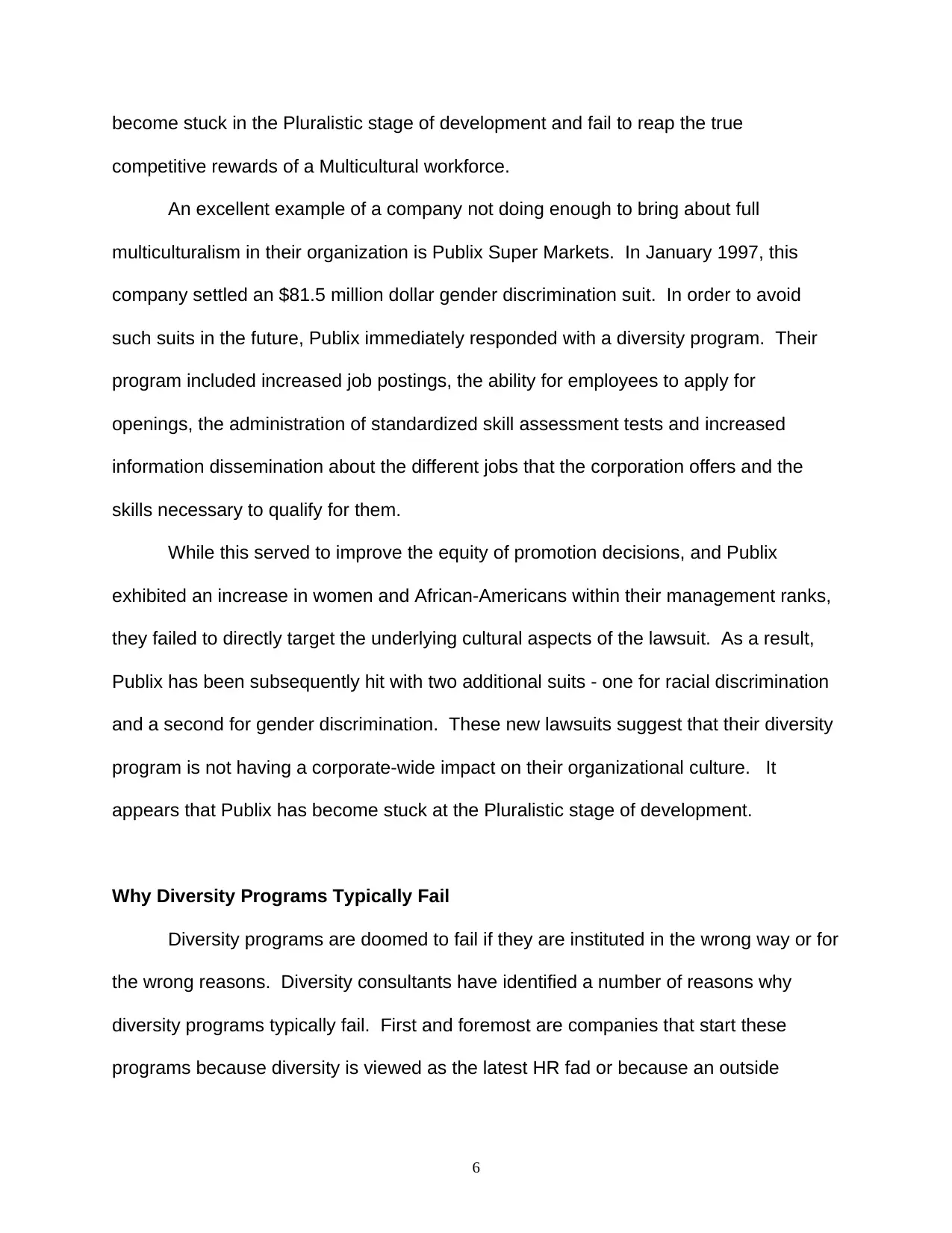
become stuck in the Pluralistic stage of development and fail to reap the true
competitive rewards of a Multicultural workforce.
An excellent example of a company not doing enough to bring about full
multiculturalism in their organization is Publix Super Markets. In January 1997, this
company settled an $81.5 million dollar gender discrimination suit. In order to avoid
such suits in the future, Publix immediately responded with a diversity program. Their
program included increased job postings, the ability for employees to apply for
openings, the administration of standardized skill assessment tests and increased
information dissemination about the different jobs that the corporation offers and the
skills necessary to qualify for them.
While this served to improve the equity of promotion decisions, and Publix
exhibited an increase in women and African-Americans within their management ranks,
they failed to directly target the underlying cultural aspects of the lawsuit. As a result,
Publix has been subsequently hit with two additional suits - one for racial discrimination
and a second for gender discrimination. These new lawsuits suggest that their diversity
program is not having a corporate-wide impact on their organizational culture. It
appears that Publix has become stuck at the Pluralistic stage of development.
Why Diversity Programs Typically Fail
Diversity programs are doomed to fail if they are instituted in the wrong way or for
the wrong reasons. Diversity consultants have identified a number of reasons why
diversity programs typically fail. First and foremost are companies that start these
programs because diversity is viewed as the latest HR fad or because an outside
6
competitive rewards of a Multicultural workforce.
An excellent example of a company not doing enough to bring about full
multiculturalism in their organization is Publix Super Markets. In January 1997, this
company settled an $81.5 million dollar gender discrimination suit. In order to avoid
such suits in the future, Publix immediately responded with a diversity program. Their
program included increased job postings, the ability for employees to apply for
openings, the administration of standardized skill assessment tests and increased
information dissemination about the different jobs that the corporation offers and the
skills necessary to qualify for them.
While this served to improve the equity of promotion decisions, and Publix
exhibited an increase in women and African-Americans within their management ranks,
they failed to directly target the underlying cultural aspects of the lawsuit. As a result,
Publix has been subsequently hit with two additional suits - one for racial discrimination
and a second for gender discrimination. These new lawsuits suggest that their diversity
program is not having a corporate-wide impact on their organizational culture. It
appears that Publix has become stuck at the Pluralistic stage of development.
Why Diversity Programs Typically Fail
Diversity programs are doomed to fail if they are instituted in the wrong way or for
the wrong reasons. Diversity consultants have identified a number of reasons why
diversity programs typically fail. First and foremost are companies that start these
programs because diversity is viewed as the latest HR fad or because an outside
6
⊘ This is a preview!⊘
Do you want full access?
Subscribe today to unlock all pages.

Trusted by 1+ million students worldwide
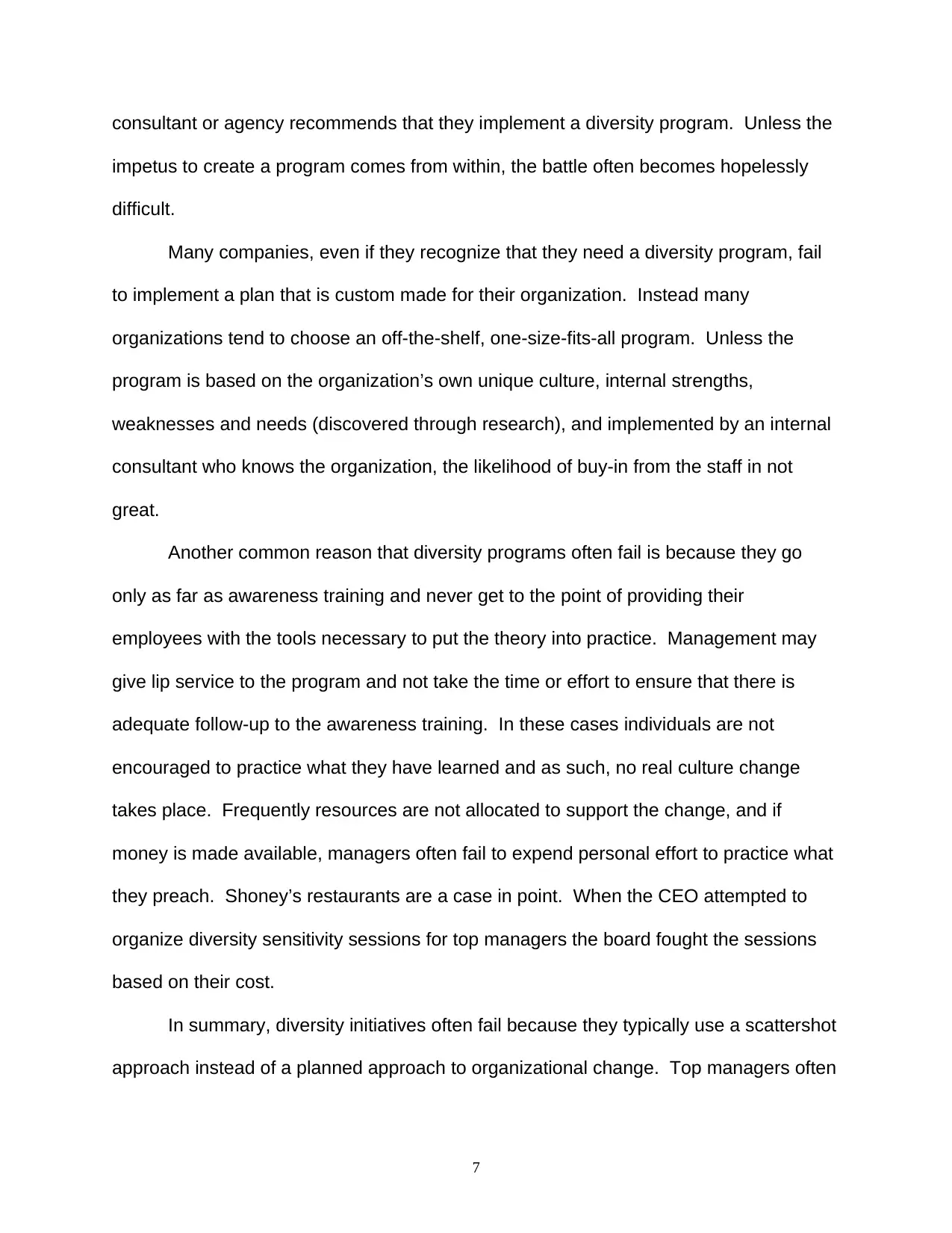
consultant or agency recommends that they implement a diversity program. Unless the
impetus to create a program comes from within, the battle often becomes hopelessly
difficult.
Many companies, even if they recognize that they need a diversity program, fail
to implement a plan that is custom made for their organization. Instead many
organizations tend to choose an off-the-shelf, one-size-fits-all program. Unless the
program is based on the organization’s own unique culture, internal strengths,
weaknesses and needs (discovered through research), and implemented by an internal
consultant who knows the organization, the likelihood of buy-in from the staff in not
great.
Another common reason that diversity programs often fail is because they go
only as far as awareness training and never get to the point of providing their
employees with the tools necessary to put the theory into practice. Management may
give lip service to the program and not take the time or effort to ensure that there is
adequate follow-up to the awareness training. In these cases individuals are not
encouraged to practice what they have learned and as such, no real culture change
takes place. Frequently resources are not allocated to support the change, and if
money is made available, managers often fail to expend personal effort to practice what
they preach. Shoney’s restaurants are a case in point. When the CEO attempted to
organize diversity sensitivity sessions for top managers the board fought the sessions
based on their cost.
In summary, diversity initiatives often fail because they typically use a scattershot
approach instead of a planned approach to organizational change. Top managers often
7
impetus to create a program comes from within, the battle often becomes hopelessly
difficult.
Many companies, even if they recognize that they need a diversity program, fail
to implement a plan that is custom made for their organization. Instead many
organizations tend to choose an off-the-shelf, one-size-fits-all program. Unless the
program is based on the organization’s own unique culture, internal strengths,
weaknesses and needs (discovered through research), and implemented by an internal
consultant who knows the organization, the likelihood of buy-in from the staff in not
great.
Another common reason that diversity programs often fail is because they go
only as far as awareness training and never get to the point of providing their
employees with the tools necessary to put the theory into practice. Management may
give lip service to the program and not take the time or effort to ensure that there is
adequate follow-up to the awareness training. In these cases individuals are not
encouraged to practice what they have learned and as such, no real culture change
takes place. Frequently resources are not allocated to support the change, and if
money is made available, managers often fail to expend personal effort to practice what
they preach. Shoney’s restaurants are a case in point. When the CEO attempted to
organize diversity sensitivity sessions for top managers the board fought the sessions
based on their cost.
In summary, diversity initiatives often fail because they typically use a scattershot
approach instead of a planned approach to organizational change. Top managers often
7
Paraphrase This Document
Need a fresh take? Get an instant paraphrase of this document with our AI Paraphraser
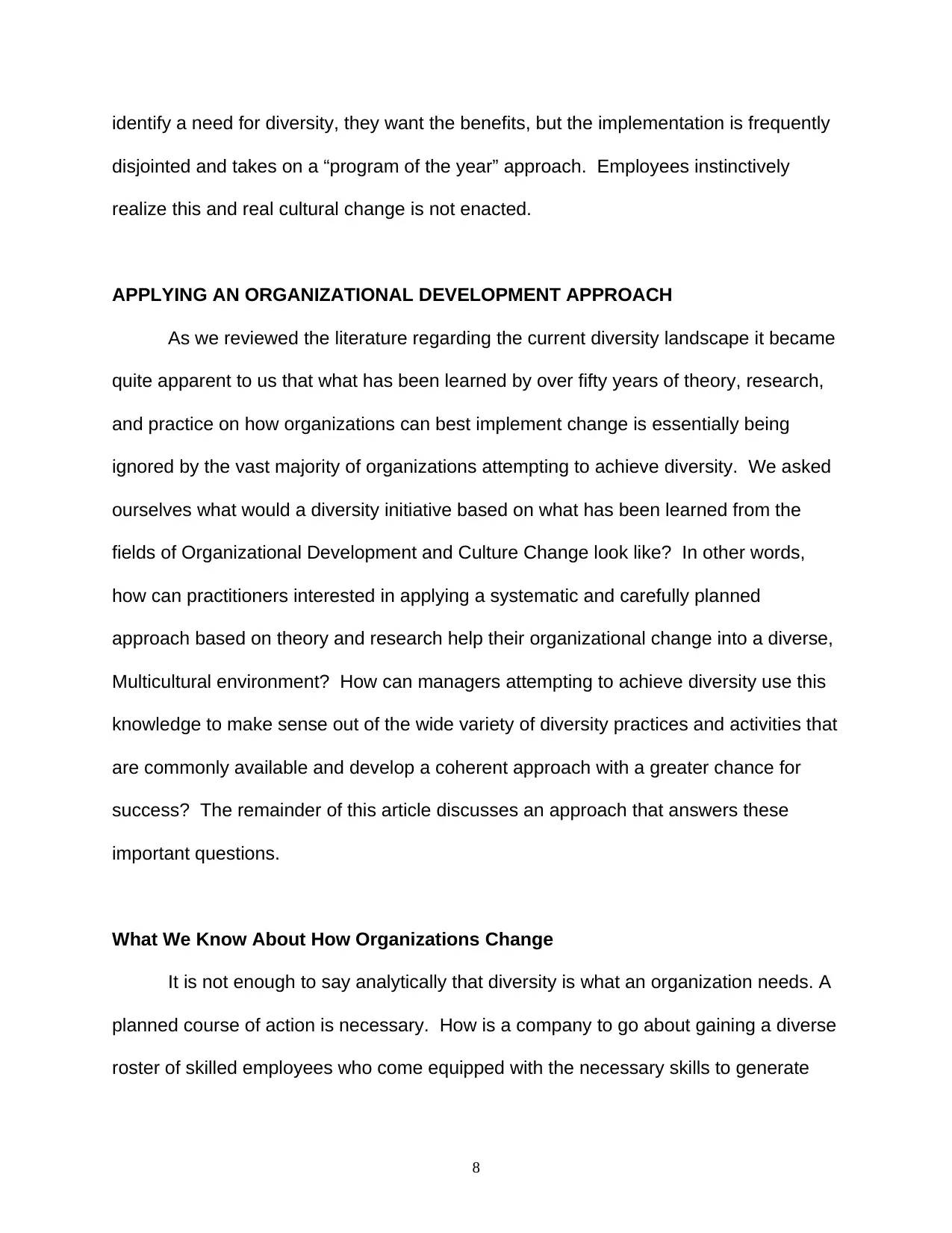
identify a need for diversity, they want the benefits, but the implementation is frequently
disjointed and takes on a “program of the year” approach. Employees instinctively
realize this and real cultural change is not enacted.
APPLYING AN ORGANIZATIONAL DEVELOPMENT APPROACH
As we reviewed the literature regarding the current diversity landscape it became
quite apparent to us that what has been learned by over fifty years of theory, research,
and practice on how organizations can best implement change is essentially being
ignored by the vast majority of organizations attempting to achieve diversity. We asked
ourselves what would a diversity initiative based on what has been learned from the
fields of Organizational Development and Culture Change look like? In other words,
how can practitioners interested in applying a systematic and carefully planned
approach based on theory and research help their organizational change into a diverse,
Multicultural environment? How can managers attempting to achieve diversity use this
knowledge to make sense out of the wide variety of diversity practices and activities that
are commonly available and develop a coherent approach with a greater chance for
success? The remainder of this article discusses an approach that answers these
important questions.
What We Know About How Organizations Change
It is not enough to say analytically that diversity is what an organization needs. A
planned course of action is necessary. How is a company to go about gaining a diverse
roster of skilled employees who come equipped with the necessary skills to generate
8
disjointed and takes on a “program of the year” approach. Employees instinctively
realize this and real cultural change is not enacted.
APPLYING AN ORGANIZATIONAL DEVELOPMENT APPROACH
As we reviewed the literature regarding the current diversity landscape it became
quite apparent to us that what has been learned by over fifty years of theory, research,
and practice on how organizations can best implement change is essentially being
ignored by the vast majority of organizations attempting to achieve diversity. We asked
ourselves what would a diversity initiative based on what has been learned from the
fields of Organizational Development and Culture Change look like? In other words,
how can practitioners interested in applying a systematic and carefully planned
approach based on theory and research help their organizational change into a diverse,
Multicultural environment? How can managers attempting to achieve diversity use this
knowledge to make sense out of the wide variety of diversity practices and activities that
are commonly available and develop a coherent approach with a greater chance for
success? The remainder of this article discusses an approach that answers these
important questions.
What We Know About How Organizations Change
It is not enough to say analytically that diversity is what an organization needs. A
planned course of action is necessary. How is a company to go about gaining a diverse
roster of skilled employees who come equipped with the necessary skills to generate
8
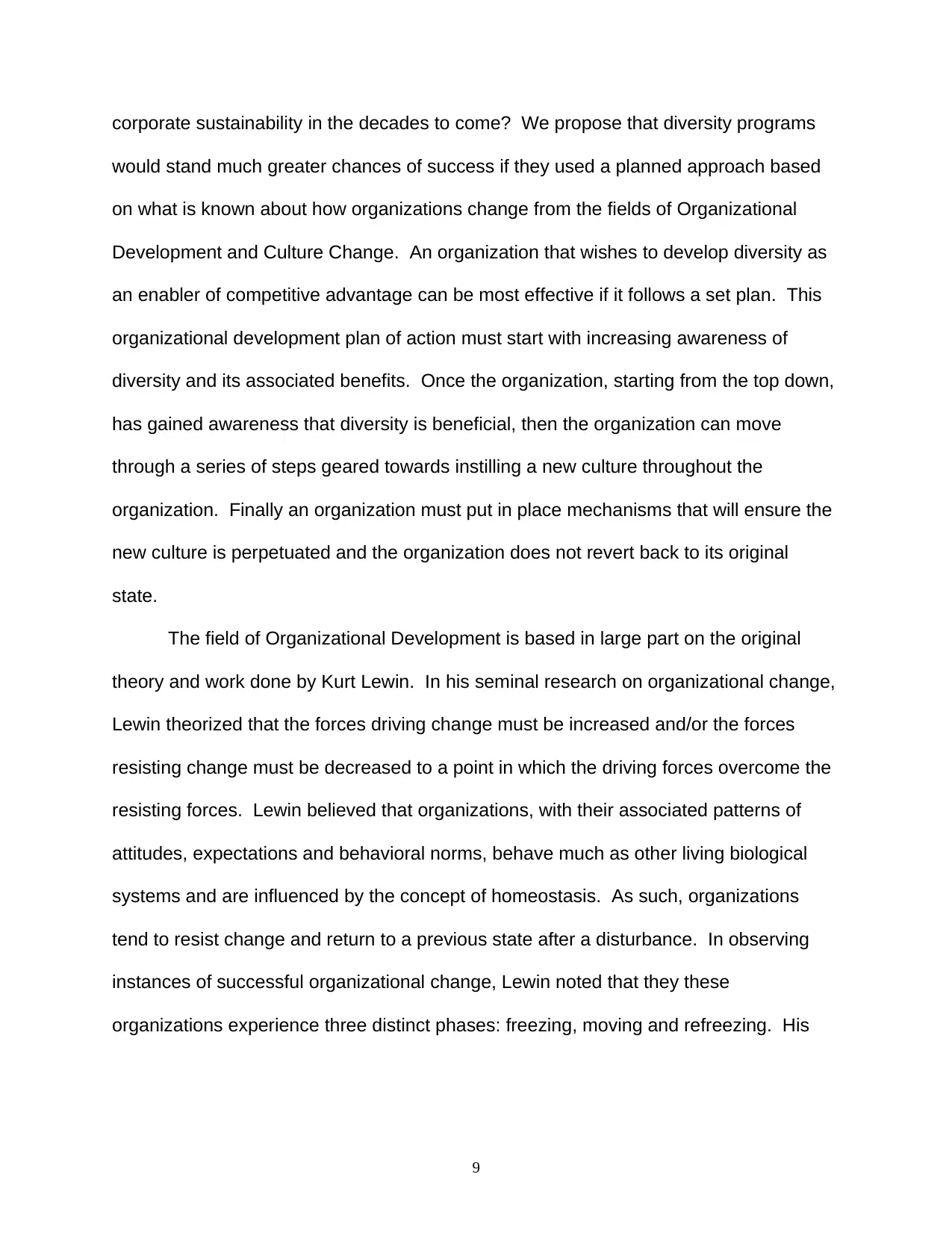
corporate sustainability in the decades to come? We propose that diversity programs
would stand much greater chances of success if they used a planned approach based
on what is known about how organizations change from the fields of Organizational
Development and Culture Change. An organization that wishes to develop diversity as
an enabler of competitive advantage can be most effective if it follows a set plan. This
organizational development plan of action must start with increasing awareness of
diversity and its associated benefits. Once the organization, starting from the top down,
has gained awareness that diversity is beneficial, then the organization can move
through a series of steps geared towards instilling a new culture throughout the
organization. Finally an organization must put in place mechanisms that will ensure the
new culture is perpetuated and the organization does not revert back to its original
state.
The field of Organizational Development is based in large part on the original
theory and work done by Kurt Lewin. In his seminal research on organizational change,
Lewin theorized that the forces driving change must be increased and/or the forces
resisting change must be decreased to a point in which the driving forces overcome the
resisting forces. Lewin believed that organizations, with their associated patterns of
attitudes, expectations and behavioral norms, behave much as other living biological
systems and are influenced by the concept of homeostasis. As such, organizations
tend to resist change and return to a previous state after a disturbance. In observing
instances of successful organizational change, Lewin noted that they these
organizations experience three distinct phases: freezing, moving and refreezing. His
9
would stand much greater chances of success if they used a planned approach based
on what is known about how organizations change from the fields of Organizational
Development and Culture Change. An organization that wishes to develop diversity as
an enabler of competitive advantage can be most effective if it follows a set plan. This
organizational development plan of action must start with increasing awareness of
diversity and its associated benefits. Once the organization, starting from the top down,
has gained awareness that diversity is beneficial, then the organization can move
through a series of steps geared towards instilling a new culture throughout the
organization. Finally an organization must put in place mechanisms that will ensure the
new culture is perpetuated and the organization does not revert back to its original
state.
The field of Organizational Development is based in large part on the original
theory and work done by Kurt Lewin. In his seminal research on organizational change,
Lewin theorized that the forces driving change must be increased and/or the forces
resisting change must be decreased to a point in which the driving forces overcome the
resisting forces. Lewin believed that organizations, with their associated patterns of
attitudes, expectations and behavioral norms, behave much as other living biological
systems and are influenced by the concept of homeostasis. As such, organizations
tend to resist change and return to a previous state after a disturbance. In observing
instances of successful organizational change, Lewin noted that they these
organizations experience three distinct phases: freezing, moving and refreezing. His
9
⊘ This is a preview!⊘
Do you want full access?
Subscribe today to unlock all pages.

Trusted by 1+ million students worldwide
1 out of 28
Your All-in-One AI-Powered Toolkit for Academic Success.
+13062052269
info@desklib.com
Available 24*7 on WhatsApp / Email
![[object Object]](/_next/static/media/star-bottom.7253800d.svg)
Unlock your academic potential
Copyright © 2020–2025 A2Z Services. All Rights Reserved. Developed and managed by ZUCOL.